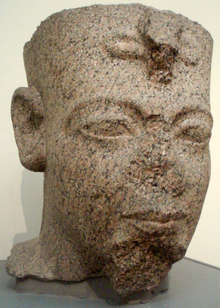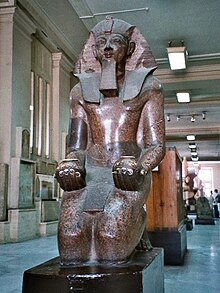Rose granite


When red granite is a rosé to red granite from Egypt called who has achieved through its extensive application in pharaonic and Roman times great popularity. The Ptolemies called him λίθος πυρροποικίλος lithos pyrrhopoikilos and the Romans lapis Syenites or lapis or marble Thebaicus .
term
As is easy to see, the German name reflects the color of roses and can also be related to the shape of some large feldspar crystals in this rock. Old Italian stonemason names for this stone are Granito roseo , Granito rosso antico , Sienite or Syenite rosé . Other names such as Granito rosso egiziano and Pyrropoecilus can be found in older literature .
In Aswan and in some countries, the term "Sienite" is also used, which is derived from the ancient name Syene of the city of Aswan. In the typical Assuan granites, there is no petrographic relationship to the Syenite rock group , but there is a fine-grained variety with a low quartz content found there.
Occurrence
The Egyptian rose granite was mined on the east bank of the Nile south of Aswan. The entire mining area extends around five kilometers in north-south and around four kilometers in west-east. A distinction is made between three mining areas: an area in the southern suburban area of Aswan, a second north of the settlement of Nakir and a third elongated, narrow area east of the other two, which extends in north-south direction, on its western side of Nubian sandstone covered.
The oldest quarries are located in the north of the entire area and close to the banks of the Nile, although some of the southern edge of the city of Aswan have recently been overbuilt. The islands of Sehelnarti , Saluga and Elephantine are also part of the ancient mining area . The proximity to the water makes it easy to transport and is also preferred for ancient quarries in other regions.
Geology, formation, properties
The deposits of igneous rocks south of Aswan do not consist of any uniform rock type. In the quarry area there are reddish-pink granites , gray granodiorites and quartz diorites , partly fine-grained or with up to 3 cm large idiomorphic crystals (granoblasts) of various feldspars. The typical rose granite is a predominantly coarse-grained rock with large, rose-colored feldspars (orthoclase). A fine-grained variety also occurs secondarily.
Existing dolerite tunnels and amphibolite deposits were used for tools on site and beyond the region. Their main application was in the hammers and other striking tools required on site.
The mineral composition is characterized by the main components quartz and biotite . The feldspar content is represented by the varieties Orthoclase , Microcline and Plagioclase . Furthermore, hornblende can be found here and there as a greenish component and calcite as the primary formation to fill in the smallest of spaces. Titanite , allanite , zirconium and apatite have been found in trace minerals .
The first geological descriptions of the Assuan granite have come down to us from François-Michel de Rozière (1809) and A. Delesse (1850). The early systematic geological explorations of the area began in the spring of 1865 by John Clarke Hawkshaw and his description. The first geological map covering the mining area was published by J. Ball in 1907. In the explanatory report, this geologist describes the rocks in the vicinity, ignoring the granodiorites by assigning them to the syenites. In the 1950s, Amin R. Gindy examined the area very comprehensively and gave what is probably the most detailed geological description to date. (e.g.)
History, forms of application
Rock extraction began with the exploitation of the sea of rocks formed by natural weathering ( wool sack weathering ) and formed the basis of those activities.
According to Klemm (see literature), organized granite mining began in the time under Djoser (reign around 2690 to around 2670 BC / 3rd Dynasty ) and Cheops . It was used to supply the pyramid construction. In other sources, the beginning of its technically organized processing is even put on 2,700 BC. Dated.
Extraction reached a significant technical level in the era of Radjedef and Chefren ( 4th dynasty ). The application history of this granite extends over several millennia and was already characterized by an accomplished, technically organized stone processing around 4,600 years ago! In this context, it should be emphasized that at this point in time there was already a wide range of previous technological experience in stone processing from the pre-dynastic era. Stone vessels made of hard rock with an astonishing surface quality and inside with drill marks are known from many finds, which are an interesting testimony to this.
According to calculations in archaeological research, the amount of rock (rose granite and other rocks) extracted in the Old Kingdom up to the Roman period was determined to be around 220,000 cubic meters in this area. In Roman times it was even a multiple of this value.
According to the semi-finished products found in the quarry areas or objects damaged during production, a wide range of applications can be stated. There are column fragments, half-finished statues, bathtubs or a sarcophagus blank.
The respective technical development epochs can be observed on traces of processing. The oldest technique is shown by the pharaonic traces of dolerite hammers, with which the raw blocks were exposed through lateral grooves (grooves). This is followed by the Ptolemaic chisel grooves and the Roman wedge groove grooves. Dolerite balls (hammering tools that have become blunt), rubble and rough stone blocks are present throughout the area. The dolerite hammers come from the aforementioned dolerite dikes in the quarry area and from another deposit in the eastern desert .
Varieties and Competing Rocks
The rose granite occurs in Aswan in a light pink and in a dark pink-red variety. There is a color transition from the gray granodiorite found in the area.
Rose granite is still mined in Egypt today. With a mining period of around 4,700 years, it is one of the oldest natural stones in use in the Europe - Middle East region.
The French Côte de Granit Rose is an important European occurrence . In the Jizera Mountains , not far from the town of Reichenberg ( Liberec ), granite with large red feldspars is mined. It bears a certain resemblance to some varieties of Egyptian rose granite and has therefore occasionally been sold under the trade name Liberec rose granite .
Application examples
Egypt
- Unfinished obelisk in the northern part of the Aswan quarry area
- Cheops pyramid, cladding material for the queen's chamber
- Burial chamber under the Djoser pyramid
- Columns and other components from the pyramid temple of Sahure in Abusir
- Statues of the Old Kingdom in the Egyptian Museum Cairo (from Giza 4th Dynasty, from Saqqara 5th / 6th Dynasty)
- Components of the Mastabat al-Firʿaun (tomb of the ancient Egyptian king Sheepseskaf )
- old dam near Aswan (built between 1899 and 1902)
- Pompey column in Alexandria
- Apis bull sarcophagi in Saqqara, in the Serapeum (granodiorite of Aswan)
- Anthropoid sarcophagus of the priest Piay
See also
Web links
Individual evidence
- ↑ Gabriele Borghini (ed.): Marmi antichi . Roma (Edizioni de Luca) 2001, pp. 225-226 ISBN 88-8016-181-4
- ^ Max Blanckenhorn: Handbook of Regional Geology, Vol. VII, Part 9 Egypt . Heidelberg (Carl Winter's University Bookstore), ca.1921, p. 36
- ^ JC Hawkshaw: Geological Description of the First Cataract, Upper Nile . in: Quarterly Journal of the Geological Society, 1867, vol. 23; Issue 1-2; Pp. 115-119
- ^ J. Ball: A description of the first or Aswan cataract of the Nile, Egypt . in: Egypt. Survey Department Cairo, 1907 Cairo, p. 121
- ↑ AR Gindy: The igneous rocks and metamorphic rocks of Aswan area, Egypt . (with a new geological map o the area and tables of rock analyzes). Bulletin de l'Institut du Désert d'Égypte Vol. 37, pp. 83-120
- ↑ G. Galetti / L. Lazzarini / M. Maggetti: A first characterization of the most important granites used in Antiquity . in: Acta Archaeologica Lovaniensia (4) Ancient Stones: Quarrying, trade and Provenance. Leuven (Leuven University Press) 1992, pp. 167-173
- ↑ J. Röder: On the quarry history of the rose granite of Aswan . in: Archäologischer Anzeiger (JB of the German Archaeological Institute) 1965, pp. 467–552
- ↑ A. Lucas / J. Harris: Ancient Egyptian materials and industries . London 1962, p. 410
- ^ Max Blanckenhorn : Handbook of Regional Geology, Vol. VII, Part 9 Egypt . Heidelberg (Carl Winter's University Bookstore), ca.1923, p. 209
literature
- Max Blanckenhorn : Handbook of Regional Geology, Vol. VII, Part 9 Egypt . Heidelberg (Carl Winter's university bookstore), ca.1921
- Rosemarie Klemm , Dietrich Klemm : Stones and Quarries in Ancient Egypt ; Berlin, Heideberg 1993 ISBN 3-540-54685-5




